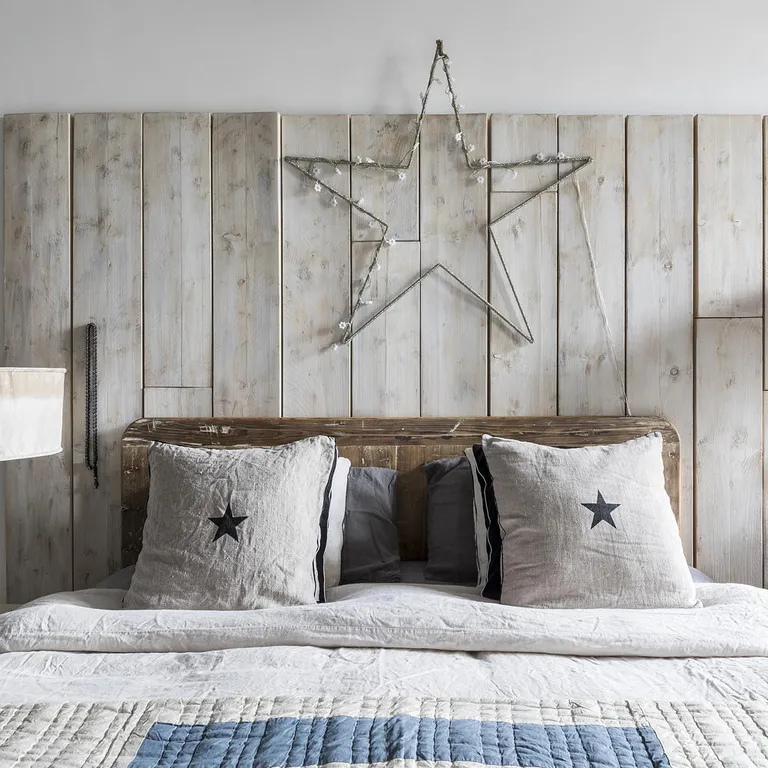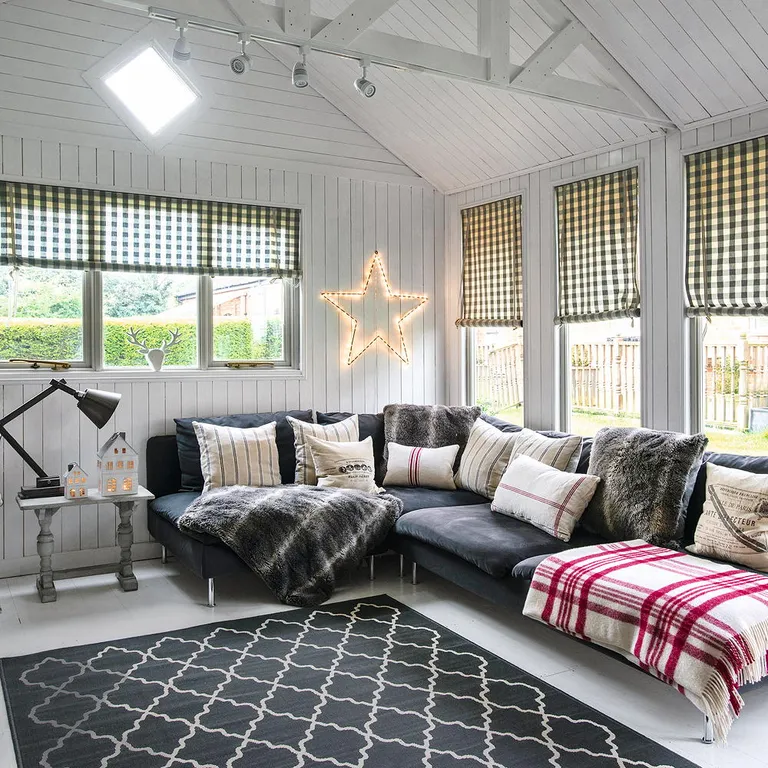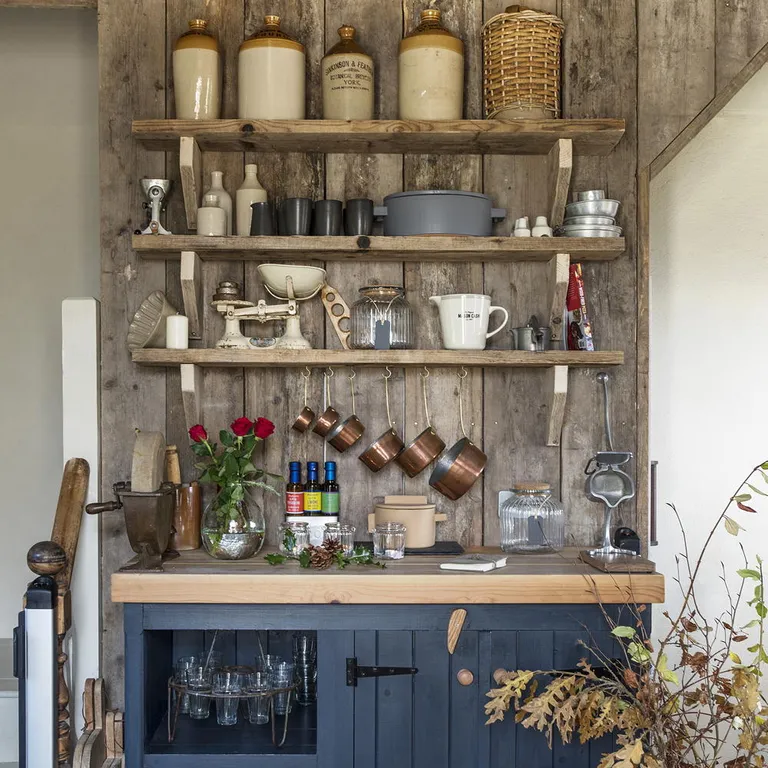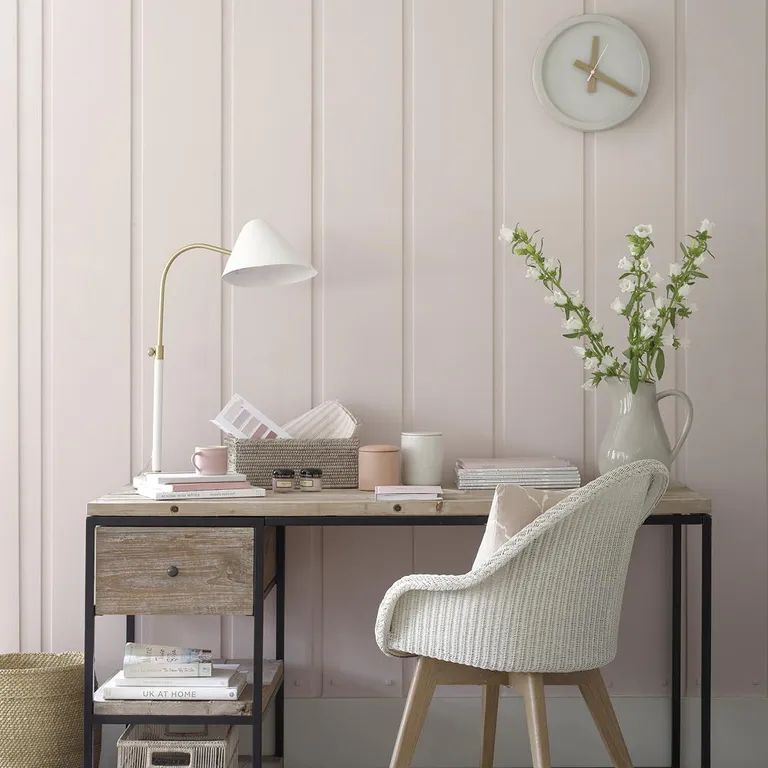If you’re after a country house look or hoping to give a space more traditional charm, panelling is a great way to update a room. It’s a simple way to bring architectural shape to featureless rooms, while protecting walls from the general wear and tear of family life.
For more ideas to transform you home, see our DIY and decorating
Available in a wide range of mouldings, from subtle tongue and groove to grand period designs, there’s a panelling style to suit every bathroom, living room, kitchen… basically any room you can think off.
Read on to discover our favourite wall panelling ideas, plus some tips on how to fit panelling in your home.
1. Consider panelling as an alternative to tiles

Image credit: Oliver Gordon
Panelling is a great way to make a statement in a bathroom instead of tiles, and you can top it with a narrow shelf to provide storage for toiletries or candles that will make bath times all the more relaxing.
But surely wood panelling will warp in a steamy bathroom? Not if you get a suitable material. ‘Panelling with a half-round bead profile can be made on moisture-resistant MDF sheeting,’ says Joan Madeley, co-founder of The English Panelling Company. ‘It looks like the real thing after painting, and is perfect for boxing in pipeworks.’
2. Incorporate a peg rail

Image credit: Simon Whitmore
The style of panelling in this study is the easiest to achieve. All it involves are attaching a few strips of wood to the walls to create box shapes and painting everything the same shade.
A horizontal piece of wood provides a perfect opportunity to incorporate a peg rail as the wall has been reinforced. It’s a great way to sneak in a little extra storage for hanging coats or other bits and pieces.
3. Cheat wall panelling with a head board

Image credit: Chris Snook
If you live in rented accommodation or aren’t ready to commit to wood panelling in your room, you can always fake it with a headboard like in this bedroom. This bleached rustic design is far wider than the bed and adds an extra layer of texture and colour to this room.
However, what is even handier is you can easily attach accessories to it, without permanent damage to your walls.
4. Fake it with tiles

Image credit: Polly Eltes
At first glance, this modern panelling looks like wood – but it is, in fact, porcelain. Advanced manufacturing techniques make it possible to create super-realistic tiles with the fine detail and texture of wood, and without the concerns about warping in a bathroom.
Running them horizontally and matching them to the floor tricks the eye into thinking the room is wider than it is. However, it can sometimes make a ceiling feel lower, so be careful about using it in a small room.
5. Add character to a room devoid of features

Image credit: Alun Callender
Here, Jacobean-style panelling adds some period drama to a dining room. It’s full of character and a little more formal than tongue and groove. Run the panels only a third of the way up the wall to make a ceiling seem higher.
‘Panelling looks at its best if it is one-third or two-thirds of the way up the wall, or full height,’ says Jon Madeley, co-founder of The English Panelling Company. ‘If panelling runs only half-way up the wall it can run the risk of making the ceiling look lower than it is.’
6. Use wide floor-to-ceiling wall panelling for a contemporary look

Image credit: Paul Raeside
Panelling is a great way to add character to a modern kitchen. The wide tongue and groove panels give this room a polished contemporary look.
Full wall panelling is great if you are looking to cover up uneven walls. It also works a treat here in disguising the pantry door.
7. Use white tongue-and-groove panels for a coastal look

Image credit: Polly Eltes
Whitewashed panels like this summon images of seaside beach huts. The thin panels crisscrossing over the walls and ceiling give the room a rustic appeal which can be easily maintained with just a lick of paint. It also works wonders at bouncing the light around a room.
8. Paint half-wall panelling a light colour

Image credit: Polly Eltes
As we’ve mentioned, panelling half a wall can run the risk of making a ceiling look smaller than it is. Avoid this by painting the panels in a pale shade such as this grey, but keep it slightly darker than the wall.
Make any radiators or pipe work blend in by painting in the same shade as the panelling, to avoid detracting from the panelling itself.
9. Make a feature wall out of reclaimed wood

Image credit: Polly Eltes
Reclaimed wood can be a gorgeously eco-friendly way to create a feature wall in a kitchen. It can be a little more expensive than other forms of tongue-and-groove panelling, if you purchase it from a specialist.
However, if you are willing to do a bit of rummaging at a salvage yard and put in a little elbow grease with a saw and sand paper, it could be a great way to score serious style points on a budget.
10. Paint panelling in blush pink for a modern twist

Image credit: Dominic Blackmore
Tongue-and-groove wall panels are perfect for painting in a whole range of colours. The sky is the limit on your colour choice, but on-trend options include pale pink and dark charcoal grey.
If you’re considering panelling as a DIY project, these boards are very easy to put up. As the name suggests the boards are designed to slot together and are ‘secret nailed’ to supporting patterns. The newer lookalike versions consist of sheets of MDF with the v-joint profile already routed. They’re stable and can even be fitted to a wall that’s not perfectly flat.
11. Frame a large window with panels

Image credit: David Giles
A large window shouldn’t get in the way of adding wall panelling in your bathroom. Jacobean style panels do a great job of mimicking the shape of the window and framing it.
Faking the panel look is easier than it looks – simply use thin strips of MDF to create a grid. Space the strips out as close together or far apart to achieve the size of panel you’re going for and paint in one colour to achieve the look.
Wall panelling – everything you need to know
What are the benefits of panelling?
Besides looking fabulous, panelling is a quick-fix solution for older walls in less-than-perfect condition. As long as the plaster isn’t blown, and you’ve dealt with any damp, panelling can be popped right over existing walls for an instant neat finish.
In the bathroom it makes a warmer alternative to tiles.
Does it have to be made from MDF?
Wood is the traditional material used for wall panels but if you’re going for a more modern painted finish, MDF is much better value and is actually a very stable board. In high-moisture environments, like bathrooms, it’s essential to use Moisture Resistant (MR) MDF.
Proficiently painted with an eggshell finish, it will cope admirably with splashes, but not total immersion, so don’t use it in the shower.
Can I install wall panelling myself?
It depends on ability but there are plenty of panelling kits designed specifically for DIYers. These tend to be MDF-based (solid timber requires professional skills/ tools) and can be simply glued onto the walls using a ‘No Nails’ type adhesive.
Things can get complicated if there are tricky alcoves and windows to work around, so it may be worth hiring a local carpenter or handyman to ensure smart results – use Rated People to find local trades.

Image credit: Brent Darby
What height should wall panelling be?
The top of the panelling should sit either a third or two-thirds of the way up the wall. Dividing the wall in half can make the ceilings fell lower. do work with existing architectural features – running panelling up to a picture rail is very effective – and think about the height of windows and sanitary ware. Don’t forget to include access panels to any isolation valves or cisterns for plumbing maintenance.
How do I make DIY wall panelling look professional?
Most panelling specialists supply matching dado rails, which can be used to hide a multitude of levelling sins, leaving a crisp connection between panelling and wall. Installing skirting over the top of panelling will do the same at floor level.
How do I paint wall panelling?
Depending on the style of panelling, it is usually best to paint it all in one colour, especially if you have used MDF pieces, to make the whole wall look like one piece of panelling.
The post Wall panelling ideas for every room – from traditional to contemporary appeared first on Ideal Home.
from Ideal Home https://ift.tt/2yjLryQ
No comments:
Post a Comment